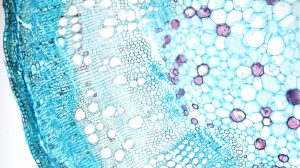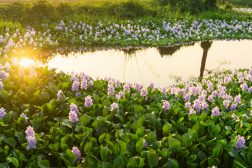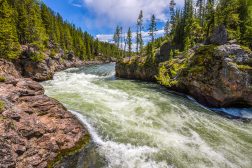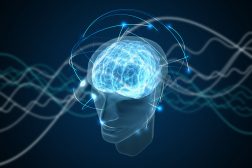Definition
noun, plural: phycobilins
A water-soluble accessory pigment found in red algae and cyanobacteria
Supplement
Photosynthetic autotrophs have pigments that absorb light energy to synthesize complex organic material from inorganic sources. There are three basic types of photosynthetic pigments: (1) chlorophylls, (2) carotenoids, and (3) phycobilins. Chlorophyll is the major light-absorbing pigment within the chloroplast of photoautotrophs, such as higher plants. There are photoautotrophs that have additional pigments to aid in light absorption. Their pigments act as an accessory, thus the name accessory pigments, in a way that they do not transfer light energy directly to the photosynthetic pathway but to the primary pigment, chlorophyll. Examples of accessory pigments are carotenoids and phycobilins. One of the distinctive features of phycobilins is their water solubility. In contrast to carotenoids that are insoluble to water, phycobilins are water-soluble proteins.
Phycobilins are found in red algae and cryptomonads. They are also found in cyanobacteria. Inside the cells of these organisms, the phycobilins collect light energy from the sun and pass this energy to the primary pigment, which is the chlorophyll. In eukaryotes such as red algae, they are found in the stroma of the chloroplast. In prokaryotes such as cyanobacteria, they are found in the cytoplasm. The light energy they absorb is essential for the production of organic molecules by the process of photosynthesis.
Phycobilins that are covalently linked to proteins are referred to as phycobiliproteins, which serve as chromophores. Examples of phycobiliproteins are phycoerythrin, phycocyanin, allophycocyanin, etc.
See also:
Dictionary > Phycobilin
You will also like...

Cell Biology
The cell is defined as the fundamental, functional unit of life. Some organisms are comprised of only one cell whereas o..

Still Water Community Plants
This tutorial looks at the adaptations of freshwater plants for them to thrive in still water habitats. Familiarize your..

Non-Mendelian Inheritance
In this tutorial, find out more about certain types of inheritance that does not follow the Mendelian inheritance patter..

Meiosis – The Genetics of Reproduction
Meiosis is a form of cell division that creates gametes. It is comprised of two divisions that in the end, the resulting..

Running Water Freshwater Communities
This tutorial introduces flowing water communities, which bring new and dithering factors into the equation for possible..

Consciousness and Behavior
Human consciousness and behavior are an interesting topic since they are determined and controlled by the brain. Conscio..

